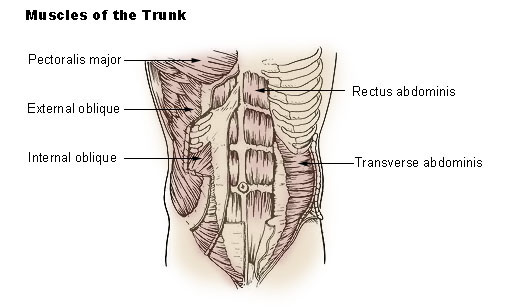Muscles of the Trunk
The muscles of the trunk include those that move the vertebral column, the muscles that form the thoracic and abdominal walls, and those that cover the pelvic outlet.

The erector spinae group of muscles on each side of the vertebral column is a large muscle mass that extends from the sacrum to the skull. These muscles are primarily responsible for extending the vertebral column to maintain erect posture. The deep back muscles occupy the space between the spinous and transverse processes of adjacent vertebrae.
The muscles of the thoracic wall are involved primarily in the process of breathing. The intercostal muscles are located in spaces between the ribs. They contract during forced expiration. External intercostal muscles contract to elevate the ribs during the inspiration phase of breathing. The diaphragm is a dome-shaped muscle that forms a partition between the thorax and the abdomen. It has three openings in it for structures that have to pass from the thorax to the abdomen.
The abdomen, unlike the thorax and pelvis, has no bony reinforcements or protection. The wall consists entirely of four muscle pairs, arranged in layers, and the fascia that envelops them. The abdominal wall muscles are identified in the illustration below.
The pelvic outlet is formed by two muscular sheets and their associated fascia.
Suggested Citation
SEER Training Modules: Muscles of the Trunk. U.S. National Institutes of Health, National Cancer Institute. Cited 21 January 2026. Available from: https://training.seer.cancer.gov.




